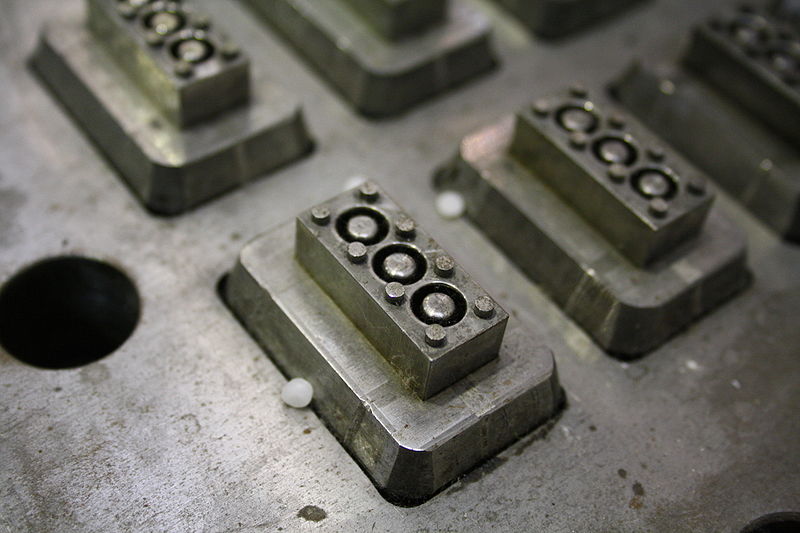When choosing your tooling material, the expected volume of your production will have a great bearing on what material will best suit your needs. For example, a mold made of hardened tool steel will guarantee a minimum of 50,000 cycles before needing maintenance, while an aluminum mold may only produce for 500-2,000 cycles before deformation occurs.
Why is Tooling Material Important?
What tooling material you choose for your mold will greatly influence your production. Areas that may be affected by this material choice are cycle time, volume, cost, maintenance, part material, and more. To avoid problems, you should be well-informed on the pros and cons of the various tooling material options.
While there are different types of steel and alloys available for molds, this article will focus on hardened tool steel and aluminum because they are the most common materials used for plastic material injection mold tooling.
Hardened Tool Steel
 Hardened tool steel is considered to be the superior tooling material for high volume injection molding. Its resistance to wear and tear allows it to be used for thousands or even millions of injection mold cycles, meaning a mold cut from this material may last years without deformation. Because this type of tool steel has such superb hardness and durability, it is expensive to manufacture and will cost more up-front than other tooling materials. However, due to these same characteristics, its long-term maintenance costs will be less frequent. Further qualities that make this material popular are its corrosion resistance, thermal stability, and polishing ability for excellent surface finish.
Hardened tool steel is considered to be the superior tooling material for high volume injection molding. Its resistance to wear and tear allows it to be used for thousands or even millions of injection mold cycles, meaning a mold cut from this material may last years without deformation. Because this type of tool steel has such superb hardness and durability, it is expensive to manufacture and will cost more up-front than other tooling materials. However, due to these same characteristics, its long-term maintenance costs will be less frequent. Further qualities that make this material popular are its corrosion resistance, thermal stability, and polishing ability for excellent surface finish.
These great mechanical properties, however, also cause a few problem areas that must be considered when deciding if hardened tool steel is the right material for your production. As stated above, this material is more expensive to cut. This is because the hardness is high enough to demand the use of specialized cutting tools, and thus it takes more effort and time to cut than other materials, such as aluminum. It must also be heat treated after machining. While this is not unusual, hardened tool steel can withstand extreme temperatures and pressure for high temp materials, and the annealing process would need to run at a more elevated temperature to work properly. Additionally, hardened tool steel is not very thermally conductive, meaning parts may take longer to cool, therefore lengthening cycle time.
Aluminum
Aluminum is used as a cheaper alternative to many types of steel and is primarily used for low volume productions. This is because aluminum is a softer metal, and only a couple thousand units may be produced before deformation of the mold begins and parts are produced with nonconformities. If a larger volume of parts is desired, the mold will need frequent maintenance or new molds will need to be cut. This increases overall tooling costs, but because aluminum is easy to machine, its up-front cost is kept lower than other tooling materials. This also makes it useful for prototyping your parts before you invest in hardened tool steel.  Another few areas of concern for this material may be that it cannot withstand high temperatures or pressure and its low density restricts your surface finish/texture choices.
Another few areas of concern for this material may be that it cannot withstand high temperatures or pressure and its low density restricts your surface finish/texture choices.
In addition to lower cost, aluminum has the upper hand on hardened tool steel in regards to heat transfer and cooling time. Aluminum possesses better thermal conductivity, which allows parts to cool faster. This also helps with mold design because cooling line placement is not as critical. Additionally, aluminum molds do not require annealing before use, which makes their production quicker so you can start injection molding sooner.
3D Printed Tooling
Depending on the tooling material you choose, your mold may take anywhere from 4-8 weeks to cut. If your project time frame will not allow you to wait this long before beginning production, 3D printing your mold is a good alternative. A 3D printed injection mold can be made in as little as 48 hours, allowing you to begin your production the same week. It is highly important, however, to note that 3D printed molds are not durable and will begin to deform around 100 mold cycles. They are also very expensive. Ultimately, this type of mold is only recommended for extremely low volumes or bridge tooling.
Injection Molding at 3 Space
Here at 3 Space, we offer multiple manufacturing services, including injection molding and 3D printing. If you have any questions regarding tooling materials or whether 3D printed tooling might work well for your project, our engineers are happy to help and make suggestions based on your production goals. For more information, contact us today.
